Related Research Articles
The 8th century BC started the first day of 800 BC and ended the last day of 701 BC. The 8th century BC was a period of great change for several historically significant civilizations. In Egypt, the 23rd and 24th dynasties lead to rule from Kingdom of Kush in the 25th Dynasty. The Neo-Assyrian Empire reaches the peak of its power, conquering the Kingdom of Israel as well as nearby countries.
The 9th century BC started the first day of 900 BC and ended the last day of 801 BC. It was a period of great change for several civilizations. In Africa, Carthage is founded by the Phoenicians. In Egypt, a severe flood covers the floor of Luxor temple, and years later, a civil war starts.

Æthelberht was the King of Wessex from 860 until his death in 865. He was the third son of King Æthelwulf by his first wife, Osburh. Æthelberht was first recorded as a witness to a charter in 854. The following year Æthelwulf went on pilgrimage to Rome and appointed his oldest surviving son, Æthelbald, as king of Wessex while Æthelberht became king of the recently conquered territory of Kent. Æthelberht may have surrendered his position to his father when he returned from pilgrimage but resumed the south-eastern kingship when his father died in 858.
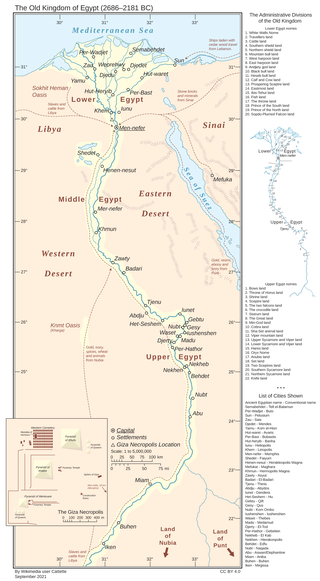
In ancient Egyptian history, the Old Kingdom is the period spanning c. 2700–2200 BC. It is also known as the "Age of the Pyramids" or the "Age of the Pyramid Builders", as it encompasses the reigns of the great pyramid-builders of the Fourth Dynasty, such as King Sneferu, who perfected the art of pyramid-building, and the kings Khufu, Khafre and Menkaure, who constructed the pyramids at Giza. Egypt attained its first sustained peak of civilization during the Old Kingdom, the first of three so-called "Kingdom" periods, which mark the high points of civilization in the lower Nile Valley.

Mithridates I, also known as Mithridates I the Great, was king of the Parthian Empire from 165 BC to 132 BC. During his reign, Parthia was transformed from a small kingdom into a major political power in the Ancient East as a result of his conquests. He first conquered Aria, Margiana and western Bactria from the Greco-Bactrians sometime in 163–155 BC, and then waged war with the Seleucid Empire, conquering Media and Atropatene in 148/7 BC. In 141 BC, he conquered Babylonia and held an official investiture ceremony in Seleucia. The kingdoms of Elymais and Characene shortly afterwards became Parthian vassals. In c. 140 BC, while Mithridates was fighting the nomadic Saka in the east, the Seleucid king Demetrius II Nicator attempted to regain the lost territories; initially successful, he was defeated and captured in 138 BC, and shortly afterwards sent to one of Mithridates I's palaces in Hyrcania. Mithridates I then punished Elymais for aiding Demetrius, and made Persis a Parthian vassal.
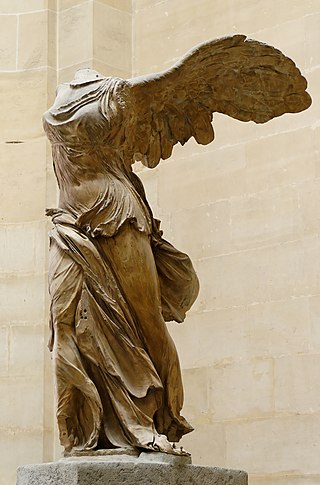
In classical antiquity, the Hellenistic period covers the time in Mediterranean history after Classical Greece, between the death of Alexander the Great in 323 BC and the death of Cleopatra VII in 30 BC, which was followed by the ascendancy of the Roman Empire, as signified by the Battle of Actium in 31 BC and the Roman conquest of Ptolemaic Egypt the following year, which eliminated the last major Hellenistic kingdom. Its name stems from the Ancient Greek word Hellas, which was gradually recognized as the name for Greece, from which the early modern 19th century historiographical term Hellenistic was derived. The term "Hellenistic" is to be distinguished from "Hellenic" in that the latter refers to Greece itself, while the former encompasses all the ancient territories of the period which had come under significant Greek influence, in particular the Hellenized Middle East, after the conquests of Alexander the Great.
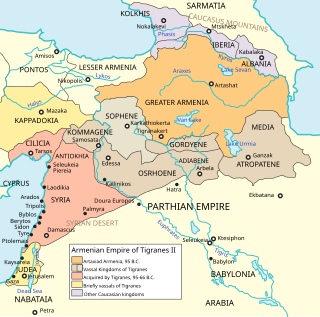
Armenia, also the Kingdom of Greater Armenia, or simply Greater Armenia or Armenia Major sometimes referred to as the Armenian Empire, was a kingdom in the Ancient Near East which existed from 331 BC to 428 AD. Its history is divided into the successive reigns of three royal dynasties: Orontid, Artaxiad and Arsacid (52–428).

Phraates II was king of the Parthian Empire from 132 BC to 127 BC. He was the son and successor of Mithridates I.

Characene, also known as Mesene (Μεσσήνη) or Meshan, was a kingdom founded by the Iranian Hyspaosines located at the head of the Persian Gulf mostly within modern day Iraq. Its capital, Charax Spasinou, was an important port for trade between Mesopotamia and India, and also provided port facilities for the city of Susa further up the Karun River. The kingdom was frequently a vassal of the Parthian Empire. Characene was mainly populated by Arabs, who spoke Aramaic as their cultural language. All rulers of the principality had Iranian names. Members of the Arsacid dynasty also ruled the state.

The High Priest of Amun or First Prophet of Amun was the highest-ranking priest in the priesthood of the ancient Egyptian god Amun. The first high priests of Amun appear in the New Kingdom of Egypt, at the beginning of the Eighteenth Dynasty.
The Caucasus region, on the gateway between Southwest Asia, Europe and Central Asia, plays a pivotal role in the peopling of Eurasia, possibly as early as during the Homo erectus expansion to Eurasia, in the Upper Paleolithic peopling of Europe, and again in the re-peopling Mesolithic Europe following the Last Glacial Maximum, and in the expansion associated with the Neolithic Revolution.

Cappadocia was a province of the Roman Empire in Anatolia, with its capital at Caesarea. It was established in 17 AD by the Emperor Tiberius, following the death of Cappadocia's last king, Archelaus.

The ancient Near East was the home of early civilizations within a region roughly corresponding to the modern Middle East: Mesopotamia, ancient Egypt, ancient Persia, Anatolia and the Armenian highlands, the Levant and the Arabian Peninsula. The ancient Near East is studied in the fields of ancient Near East studies, Near Eastern archaeology, and ancient history.
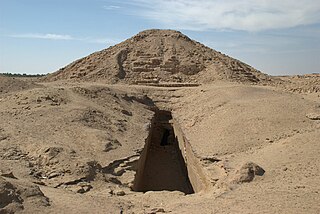
El-Kurru was the first of the three royal cemeteries used by the Kushite royals of Napata, also referred to as Egypt's 25th Dynasty, and is home to some of the royal Nubian Pyramids. It is located between the 3rd and 4th cataracts of the Nile about 1 mile (1.6 km) west of the river in what is now Northern state, Sudan. El-Kurru was first excavated by George Reisner in 1918 and 1919 and after his death his assistant Dows Dunham took over his work and published the excavation report on El-Kurru in 1950. The El Kurru cemetery was primarily used from about 860 BC until 650 BC. The first tomb with a name attached to it is that of King Piye dating to about 750 BC, the sixteen earlier tombs possibly belong to Piye's royal predecessors. The last 25th dynasty king, Tantamani, was buried at El Kurru around 650 BC. The subsequent Napatan rulers chose to be buried at the royal cemetery at Nuri instead. However, in the mid-4th century the 20th king, whose name is unknown, chose to have his tomb, as well as that of his queen, built at El Kurru.
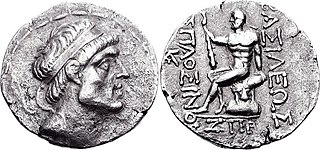
Hyspaosines was the founder of Characene, a kingdom situated in southern Mesopotamia. He was originally a Seleucid satrap installed by king Antiochus IV Epiphanes, but declared independence in 141 BC after the collapse and subsequent transfer of Seleucid authority in Iran and Babylonia to the Parthians. Hyspaosines briefly occupied the Parthian city of Babylon in 127 BC, where he is recorded in records as king (šarru). In 124 BC, however, he was forced to acknowledge Parthian suzerainty. He died in the same year, and was succeeded by his juvenile son Apodakos.
References
- ↑ Hoeh, Herman L. (1962). Compendium of World History. Vol. 1. Ambassador College. p. 392.